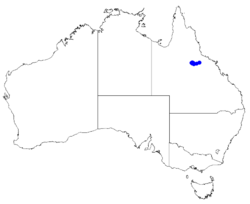Biology:Boronia warangensis
| Boronia warangensis | |
|---|---|
| Scientific classification | |
| Kingdom: | Plantae |
| Clade: | Tracheophytes |
| Clade: | Angiosperms |
| Clade: | Eudicots |
| Clade: | Rosids |
| Order: | Sapindales |
| Family: | Rutaceae |
| Genus: | Boronia |
| Species: | B. warangensis
|
| Binomial name | |
| Boronia warangensis Duretto[1]
| |

| |
| Occurrence data from Australasian Virtual Herbarium | |
Boronia warangensis is a species of erect, woody shrub that is endemic to Queensland. It has bipinnate leaves and groups of between five and twenty-five or more white flowers in leaf axils.
Description
Boronia warangensis is an erect, woody shrub that typically grows to a height of about 2 m (6 ft 7 in). It has bipinnate leaves 15–56 mm (0.59–2.20 in) long and 18–90 mm (0.71–3.54 in) wide with between five and seven leaflets on a petiole 7–17 mm (0.28–0.67 in) long. The end leaflet is 7–30 mm (0.28–1.18 in) long and 1–2.5 mm (0.039–0.098 in) wide and the side leaflets are similar but longer. The flowers are white and are arranged in groups of up between five and twenty-five or more in leaf axils on a peduncle 2–2.5 mm (0.079–0.098 in) long. The four sepals are egg-shaped, about 1 mm (0.039 in) long and wide and the four petals are about 2 mm (0.079 in) long. The stamens are hairy on their edges and the stigma is minute, scarcely wider than the style. Flowering mainly occurs from March to September and the fruit is a glabrous capsule about 3 mm (0.12 in) long and 1.5 mm (0.059 in) wide.[2][3]
Taxonomy and naming
Boronia warangensis was first formally described in 2003 by Marco F. Duretto from a specimen collected in the Warang section of the White Mountains National Park and the description was published in Muelleria.[2][4] The specific epithet (warangensis) refers to type location.[2]
Distribution and habitat
This boronia is confined to the White Mountains National Park where it grows in scrub or woodland in sandstone country.[2][3]
Conservation
Boronia warangensis is listed as "least concern" by the Queensland Government Department of Environment and Science.[5]
References
- ↑ "Boronia warangensis". https://biodiversity.org.au/nsl/services/apc-format/display/180940. Retrieved 14 March 2020.
- ↑ 2.0 2.1 2.2 2.3 Duretto, Marco F. (2003). "Notes on Boronia (Rutaceae) in eastern and northern Australia". Muelleria 17: 31–32. https://www.rbg.vic.gov.au/documents/Muelleria_17,_p19-135,_Duretto,_Notes_on_Boronia.pdf. Retrieved 14 March 2020.
- ↑ 3.0 3.1 Duretto, Marco F.; Wilson, Paul G.; Ladiges, Pauline Y.. "Boronia warangensis". Flora of Australia. Australian Biological Resources Study, Department of the Environment and Energy, Canberra. https://profiles.ala.org.au/opus/foa/profile/Boronia%20warangensis. Retrieved 14 March 2020.
- ↑ "Boronia warangensis". APNI. https://id.biodiversity.org.au/instance/apni/585010. Retrieved 14 March 2020.
- ↑ "Boronia warangensis". Queensland Government Department of Environment and Science. https://apps.des.qld.gov.au/species-search/details/?id=28277. Retrieved 14 March 2020.
Wikidata ☰ Q15391476 entry

